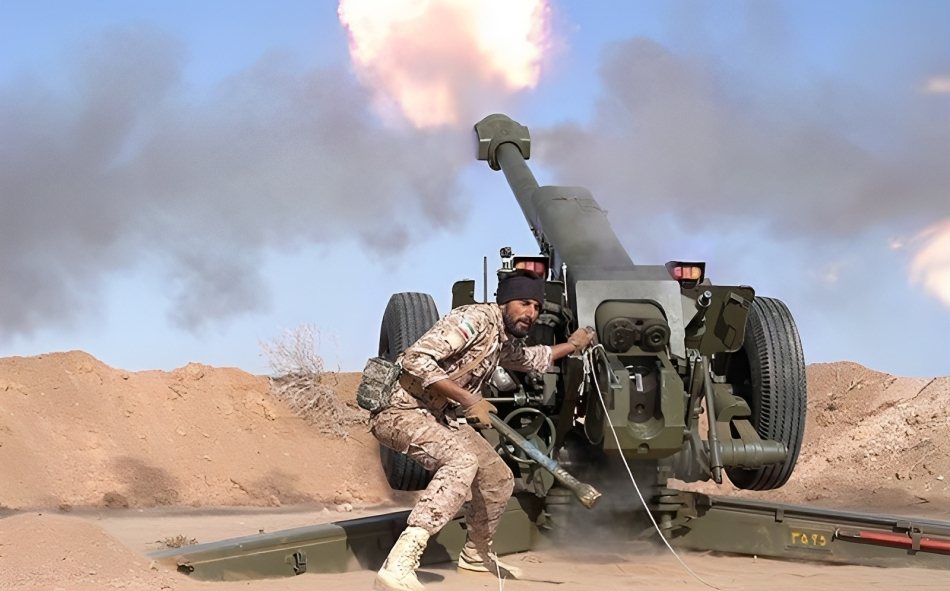Iran’s Islamic Revolution Guards Corps (IRGC) Ground Forces conducted large-scale military exercises in the country’s western province.
The drills, which “focused on countering security threats from counter-revolutionary, terrorist, and Sunni extremist groups,” were held by the Najaf-e Ashraf Base and its units in the Qasr-e Shirin area in western Kermanshah Province, as reported by Tasnim News Agency on December 11.
The IRGC troops employed a broad range of tactics in the war game, simulating electronic warfare, testing radar and telecommunication systems, conducting reconnaissance operations, destroying hypothetical enemy bases, carrying out heliborne operations, and launching strikes involving artillery, drones, and armored units.
According to the Commander of the IRGC Ground Forces, Brigadier General Mohammad Pakpour, the war game included plans to foil security threats and combat outlaw and terrorist groups. He noted that the drill also aimed at ensuring sustainable security, countering various levels of threats, protecting national interests, and safeguarding the territorial integrity of the country.
Meanwhile, the air defense force of Iran’s regular army received a fleet of Karrar drones equipped with air-to-air Majid missiles in a ceremony held at Khatam ol-Anbia University on December 10. The drones were equipped with missiles under a cooperation plan between the Air Defense Force and the Ministry of Defense and Armed Forces Logistics. During the ceremony, the Commander of the Army Air Defense Force, Brigadier General Alireza Sabahifard, stated that his force would use these drones in multiple regions across the country. The Commander-in-Chief of the Army, Major General Abdolrahim Mousavi, mentioned at the same ceremony that the Karrar drones would “increase the combat capabilities” of the air defense force.
In October, Iran’s Defense Ministry announced that they had equipped one of the Karrar combat drone models with an air interceptor missile system called Majid. The homegrown Majid air defense missile can track and intercept targets with thermal and optical seekers. The new missile-armed drones will enable air defense units to carry out air-based tactical defense operations in various geographical locations at a lower cost than the employment of manned warplanes and with much lower risks.
In September, Deputy Commander of the Iranian Army’s Air Defense Force, Brigadier General Alireza Elhami, said Karrar had been equipped with a radar. Iran unveiled its first domestically manufactured long-range combat drone, the Karrar (Striker), on August 23, 2010. It has a range of 1,000 km (620 miles) and can carry two 115 kg bombs or a precision-guided munition weighing 227 kg. The Karrar can reportedly bomb targets at high speed, using a rocket assist system to help it take off and is recovered by parachute.
In recent years, Iranian military experts and technicians have achieved self-sufficiency in domestically producing a wide array of equipment, making significant strides in the realm of weaponry. Iranian officials consistently emphasize their commitment to enhancing military capabilities, including missile and drone technology, despite Western sanctions and opposition from Israel.
Meanwhile, in late November, Ukrainian President Volodymyr Zelensky called on the EU and USA to work with Iran to prevent that country from supplying drones and missiles to Russia. The joint statement by the UK, France, and Germany on November 30 condemning Iran’s announcement of the Fattah-2 hypersonic missile was deemed unacceptable by Iran, with the missile unveiled by the IRGC at a ceremony in Tehran on November 19.







 President Ilham Aliyev shed light on the evolving contours of the peace process with Armenia during an international conference in Baku this week. ...
President Ilham Aliyev shed light on the evolving contours of the peace process with Armenia during an international conference in Baku this week. ...
 Azerbaijan and Armenia started the process of demarcation of their border on Tuesday, with the installation of the first border markers based on ge...
Azerbaijan and Armenia started the process of demarcation of their border on Tuesday, with the installation of the first border markers based on ge...
 President Aliyev emphasized the critical role of the North-South Transport Corridor in fostering transport cooperation between Azerbaijan and Russi...
President Aliyev emphasized the critical role of the North-South Transport Corridor in fostering transport cooperation between Azerbaijan and Russi...
 Iran and Pakistan have signed eight cooperation documents in various fields, and agreed to strengthen ties to fight terrorism in the region.
Iran and Pakistan have signed eight cooperation documents in various fields, and agreed to strengthen ties to fight terrorism in the region.
 As the conflict between Ukraine and Russia escalates, the strategic importance of Kharkiv, Ukraine's second-largest city, has come sharply into focus.
As the conflict between Ukraine and Russia escalates, the strategic importance of Kharkiv, Ukraine's second-largest city, has come sharply into focus.



